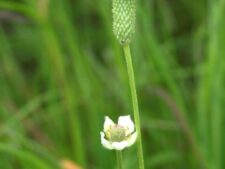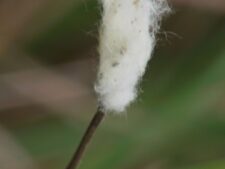
CANDLE ANEMONE
Anemone cylindrica
BUTTERCUP FAMILY (Ranunculaceae)
 Identification
Identification
- Flowering time - June, July
- Rare in prairie restoration at Neale Woods
- Greenish-white flower with 4-6 (usually 5) petal-like sepals on a long stalk
- Stalked, deeply lobed leaves
- Cylindrical seed head on long stalk - see discussion for comparison with similar Tall Anemone
This native perennial usually is 1-2 feet tall. Stems have both basal leaves 2-4 inches wide and whorl(s) typically containing 3 smaller stalked leaves on the flowering stem. All leaves are deeply lobed into 3-7 segments which are further irregularly subdivided (A). One to several long flower stalks arise from the leaf whorl. Each supports a single greenish-white flower about 1 inch across with 4-6 (usually 5) petal-like sepals (B). Fruits develop on a densely packed cylindrical head or “candle” up to 1 1/2 Inches long (C), the structure responsible for its common and botanical names. As it matures the tiny black seeds, each with an attached bit of white fluff, give the seed head a woolly, cotton-like look (D).
This anemone flowers in prairies and other open areas during June and July. It is rare at Neale Woods where a single plant was found in a prairie restoration. It has not been documented at Fontenelle Forest.
It is not always possible to separate Candle Anemone from Tall Anemone (Anemone virginiana). Candle Anemone is usually found in more open areas and, when present, the longer, more tubular seed head separates it from Tall Anemone. Stalked leaves differentiate it from Canada Anemone (Anemone canadensis) which is found in wetter soils and grows in colonies.
Gilmore states the Poncas used the woolly fruits as a good luck charm, either rubbing their hands in the smoke from the burning fruits or rubbing their palms with the chewed fruit prior to engaging in a card game.
Other common names include Long-fruited Anemone and Thimbleweed.
The content of NatureSearch is provided by dedicated volunteer Naturalists of Fontenelle Forest who strive to provide the most accurate information available. Contributors of the images retain their copyrights. The point of contact for this page is: Neal Ratzlaff.



